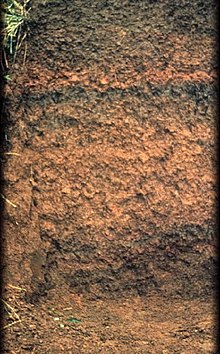Andisol
Andisol (from the property andic , derived from Japanese an do , 'dark soil' and Latin solum , 'soil') is one of the twelve orders of the USDA Soil Taxonomy . It corresponds roughly to the group of andosols in the World Reference Base for Soil Resources . It mainly includes soils of volcanic origin. Under certain weathering conditions, an andisol can be formed from non-volcanic raw material with a high proportion of aluminosilicates .
definition
The typical characteristic of Andi Sole is a predominance of by weathering little transported conversion minerals such as allophane or aluminum - humus - complexes . The formation of the subsurface on which the floor rests does not play a role, the only decisive factor is that 60% of the upper 60 cm have the characteristic andic property (see below). Soil horizons with an organic share of more than 25% are not taken into account. In detail, the definition and demarcation from other soil types includes numerous other criteria .
In the USDA soil classification, andisols are defined as soils with andic properties in more than 60% of the soil thickness either
- within the top 60 cm of mineral or organic soil with andic properties, whichever is closest to the surface, if none of the following hardened soil horizons occur
- non- cemented hard soil horizon ( densic )
- cemented to weakly cemented hard soil horizon or rock ( lithic or paralithic )
- Verkieselungshorizont ( duripan )
- Calcification horizon ( petrocalcic )
or
- between the surface of a mineral or an organic soil with andic properties, whichever is closest to the surface, and one of the above hardened soil horizons within a depth of 60 cm.
The andic property
The andic property is defined in the USDA soil classification as the property of soils with less than 25% weight percent organic carbon and one or both of the following criteria:
- In the fine fraction, all of the following criteria
- at least two percent (Al ox + ½Fe ox ) content (see below)
- maximum 0.9 kg / dm 3 storage density
- at least 85 percent phosphate retention capacity
- Alternatively, a phosphate retention capacity of 25% and more and a proportion of 30% of the grain size 0.02 - 2.0 mm in the total soil as well as one of the following criteria:
- at least 0.4% (Al ox + ½Fe ox ) content and at least 30% volcanic glass with grain sizes between 0.02 and 2.0 mm
- at least two percent (Al ox + ½Fe ox ) content and at least 5% volcanic glass with grain sizes between 0.02 and 2.0 mm
- between 0.4 and 2% (Al ox + ½Fe ox ) content and a glass content between 5 and 30% in grain sizes between 0.02 and 2.0 mm, which is shown in a diagram of the two sizes (Al ox + ½Fe ox ) Content and glass content fall within a certain range of the diagram.
It is Al ox and Fe ox of aluminum - and iron content in the acidic oxalate - extract as a percentage of the dried at 105 ° C fine soil (0-2 mm).
The andic property can be further subdivided into silandic and aluandic depending on the aluminum and silicon content .
properties
Andisols develop from volcanic ash , have a high proportion of volcanic glasses and, due to their formation, often have a considerable thickness. If several layers build up over time, typical soil profiles with brown to black colors are formed; the older layers , then called paleosol , are naturally always under the younger deposits.
Andisols are characterized by the fact that they can store large amounts of water and are also very fertile; For this reason, they are used for agriculture wherever possible. However, they are very poorly resistant to erosion. The pH value is neutral.
Occurrence
Andisols take up around 900,000 square kilometers or just under one percent of the ice-free land area worldwide and are always found near volcanoes, for example on the Pacific coast of America , on New Zealand , Japan , Indonesia , Iceland and some smaller island groups such as the Canary Islands .
classification
There are seven sub-categories:
- Aquand: an andisol with near-surface, high groundwater level for most of the year
- Terrain: more or less well drained andisol in a cold climate
- Cryand: more or less well drained andisol in a very cold climate
- Edge of the goal: more or less well drained andisol in a dry climate
- Xerand: more or less well-drained Andisol in climates with Mediterranean humidity and cool, moderate or hot temperature conditions
- Vitrand: more or less well drained, coarse andisol
- Condition: more or less well drained andisol in a semi-humid to semi-arid climate
- Udand: more or less well drained andisol in a humid climate.
literature
- Soil Taxonomy, A Basic System of Soil Classification for Making and Interpreting Soil Surveys. (PDF; 9.94 MB) pp. 80, 120, 271 f , accessed on December 13, 2009 .
Web links
- Sabine Grunwald: Andisols. Retrieved December 13, 2009 .
Individual evidence
- ^ Soil Taxonomy, A Basic System of Soil Classification for Making and Interpreting Soil Surveys. Diagram 1. (pdf; 9.94 MB) p. 81 , accessed on December 13, 2009 .
